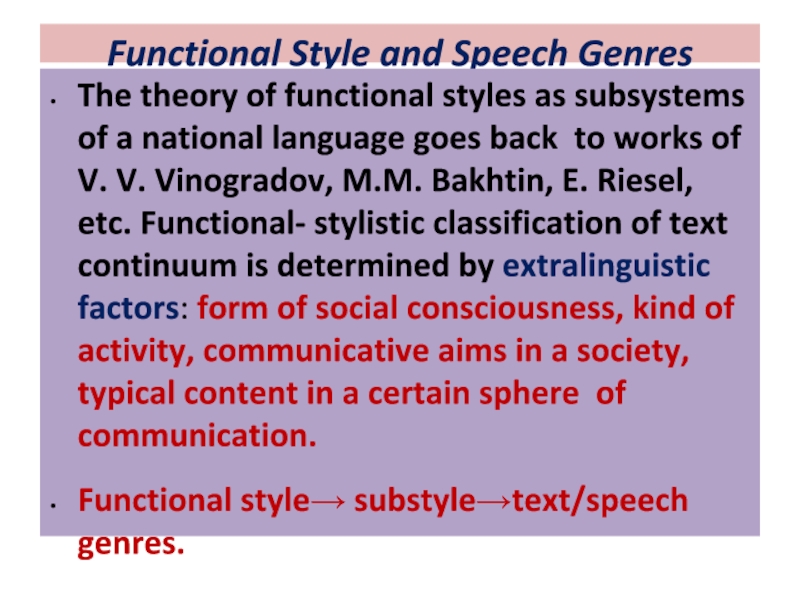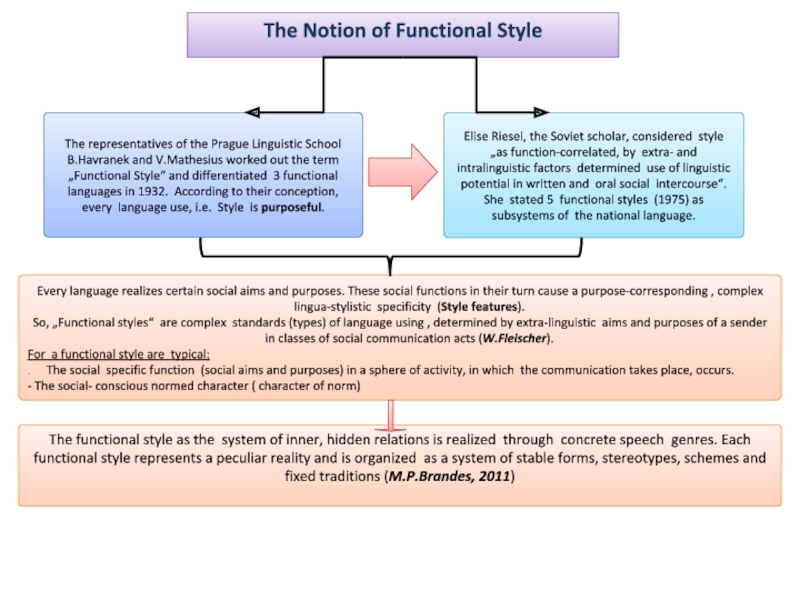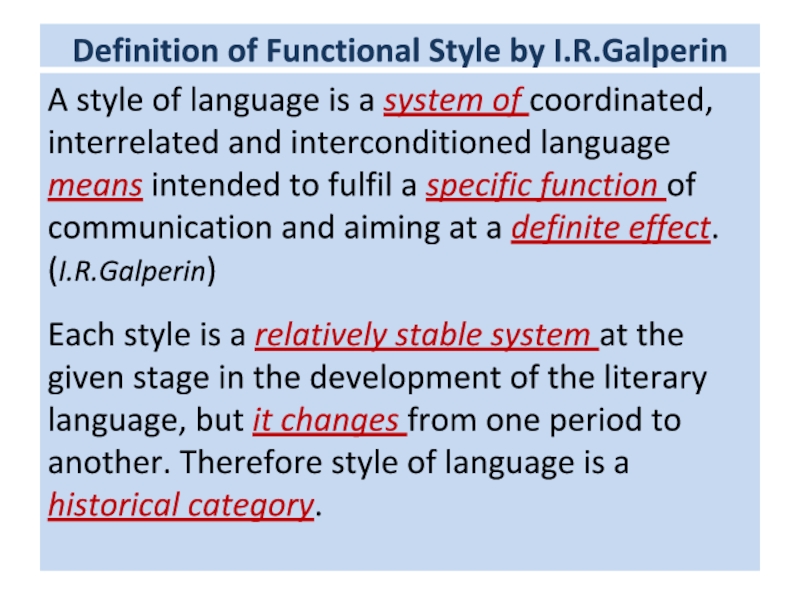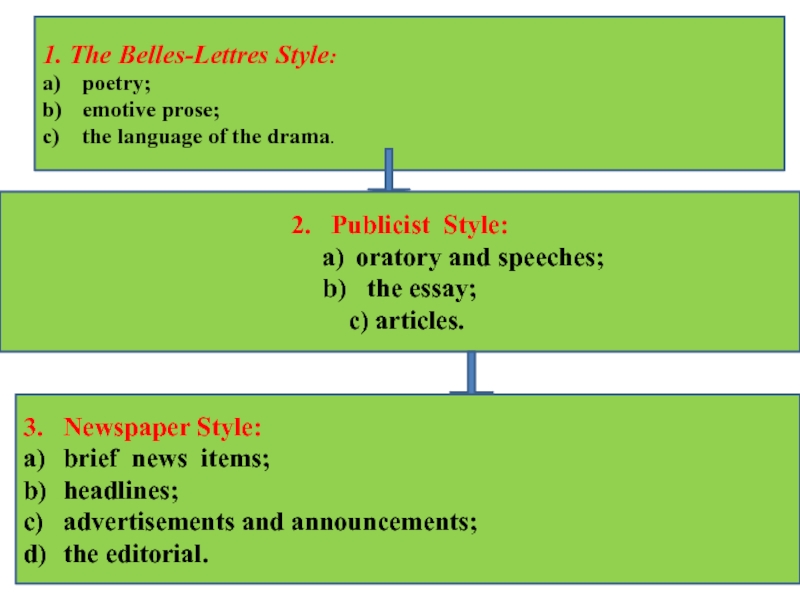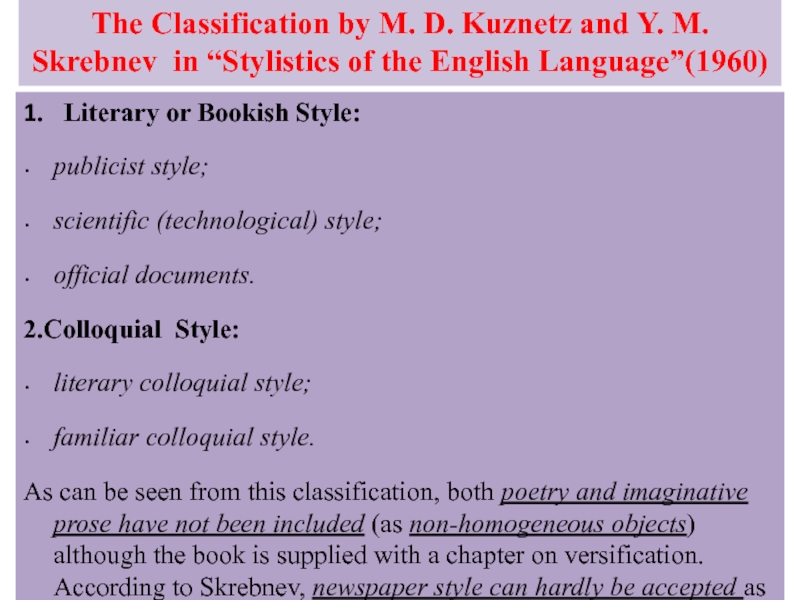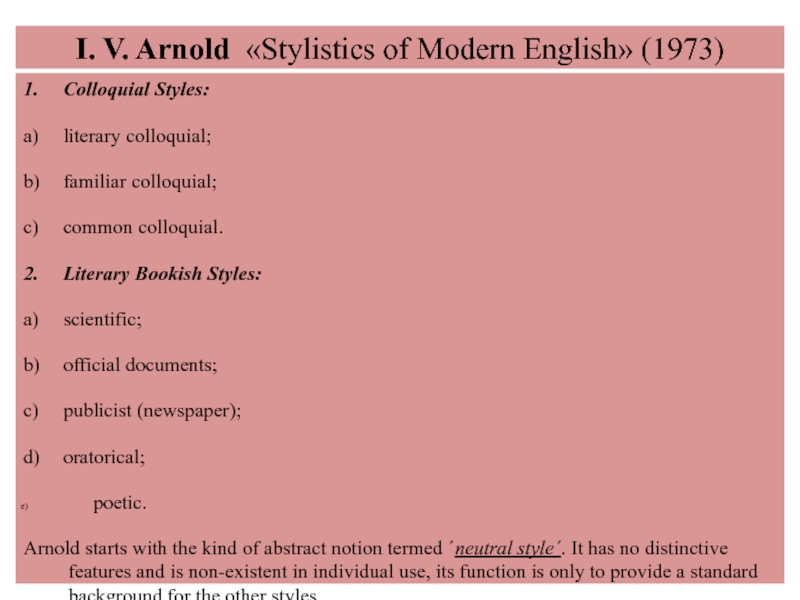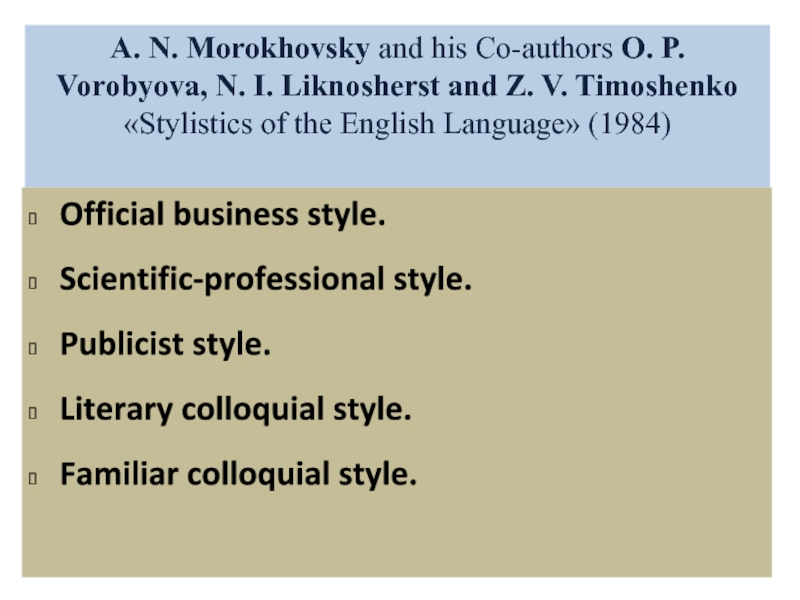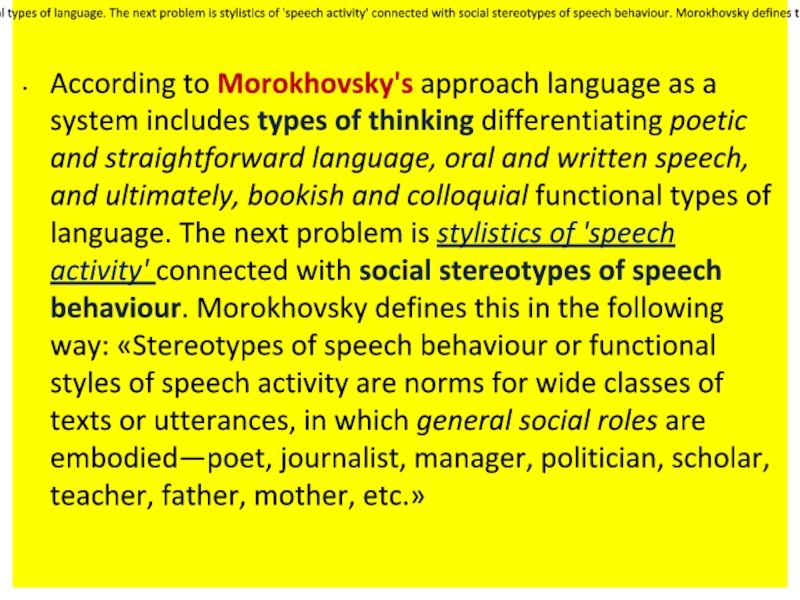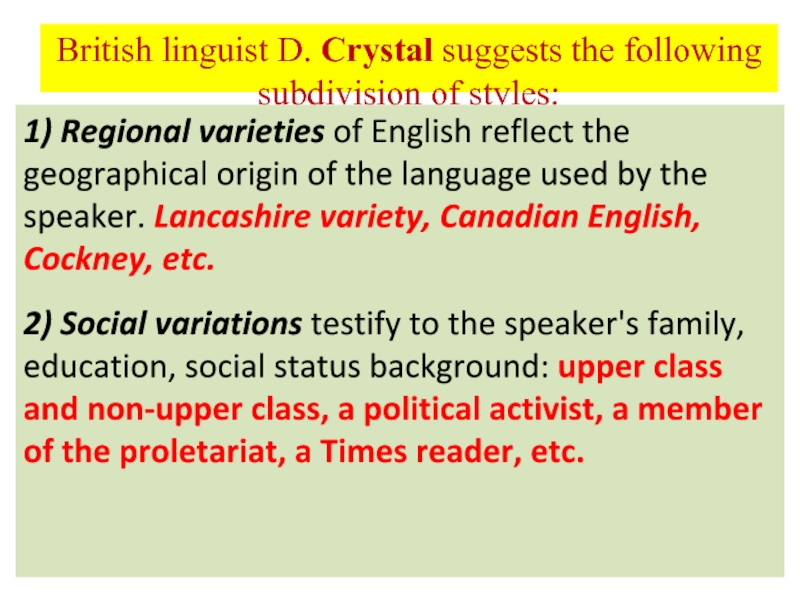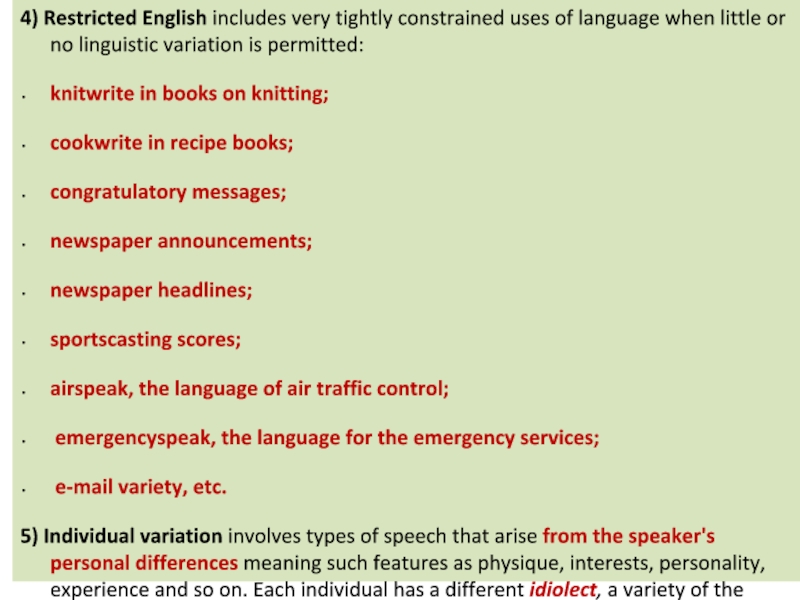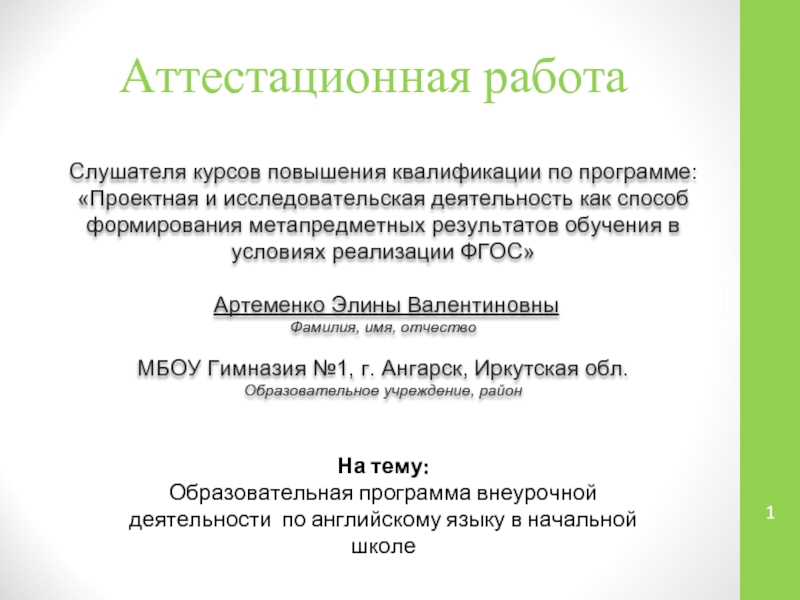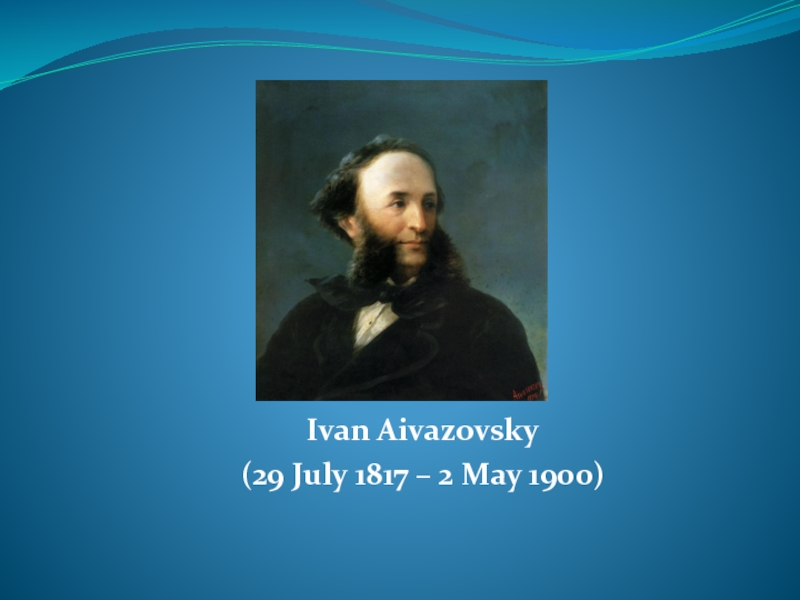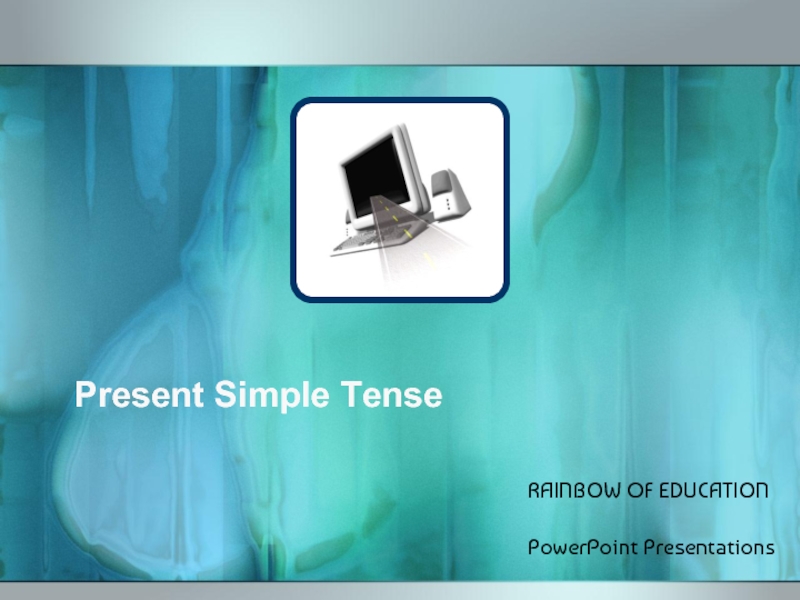- Главная
- Разное
- Дизайн
- Бизнес и предпринимательство
- Аналитика
- Образование
- Развлечения
- Красота и здоровье
- Финансы
- Государство
- Путешествия
- Спорт
- Недвижимость
- Армия
- Графика
- Культурология
- Еда и кулинария
- Лингвистика
- Английский язык
- Астрономия
- Алгебра
- Биология
- География
- Детские презентации
- Информатика
- История
- Литература
- Маркетинг
- Математика
- Медицина
- Менеджмент
- Музыка
- МХК
- Немецкий язык
- ОБЖ
- Обществознание
- Окружающий мир
- Педагогика
- Русский язык
- Технология
- Физика
- Философия
- Химия
- Шаблоны, картинки для презентаций
- Экология
- Экономика
- Юриспруденция
Content-Logical Structure of the Module презентация
Содержание
- 1. Content-Logical Structure of the Module
- 2. Functional Style and Speech Genres The theory
- 3. The Notion of Functional Style The representatives
- 4. Definition of Functional Style by I.R.Galperin
- 5. Classification of FS according to I.R.Galperin I.R.
- 6. 1. The Belles-Lettres Style: a) poetry; b) emotive
- 7. 4. Scientific Prose Style. The Style of
- 8. The Classification by M. D. Kuznetz and
- 9. I. V. Arnold «Stylistics of Modern English»
- 10. A. N. Morokhovsky and his Co-authors O.
- 11. According to Morokhovsky's approach language
- 12. British linguist D. Crystal suggests the following
- 13. 3) Occupational styles present quite a
- 14. 4) Restricted English includes very tightly
Слайд 2Functional Style and Speech Genres
The theory of functional styles as subsystems
Functional style→ substyle→text/speech genres.
Слайд 3The Notion of Functional Style
The representatives of the Prague Linguistic School
Elise Riesel, the Soviet scholar, considered style „as function-correlated, by extra- and intralinguistic factors determined use of linguistic potential in written and oral social intercourse“. She stated 5 functional styles (1975) as subsystems of the national language.
Every language realizes certain social aims and purposes. These social functions in their turn cause a purpose-corresponding , complex lingua-stylistic specificity (Style features).
So, „Functional styles“ are complex standards (types) of language using , determined by extra-linguistic aims and purposes of a sender in classes of social communication acts (W.Fleischer).
For a functional style are typical:
The social specific function (social aims and purposes) in a sphere of activity, in which the communication takes place, occurs.
- The social- conscious normed character ( character of norm)
The functional style as the system of inner, hidden relations is realized through concrete speech genres. Each functional style represents a peculiar reality and is organized as a system of stable forms, stereotypes, schemes and fixed traditions (M.P.Brandes, 2011)
Слайд 4Definition of Functional Style by I.R.Galperin
A style of language is
Each style is a relatively stable system at the given stage in the development of the literary language, but it changes from one period to another. Therefore style of language is a historical category.
Слайд 5Classification of FS according to I.R.Galperin
I.R. Galperin distinguishes 5 functional styles
1. The Belles-Lettres Style:
2. Publicist Style:
Newspaper Style:
Scientific Prose Style.
The Style of Official documents:
Слайд 6
1. The Belles-Lettres Style:
a) poetry;
b) emotive prose;
c) the language of the drama.
2. Publicist Style:
b) the essay;
c) articles.
3. Newspaper Style:
a) brief news items;
b) headlines;
c) advertisements and announcements;
d) the editorial.
Слайд 7
4. Scientific Prose Style.
The Style of Official documents:
a) business documents;
b) legal documents;
c) the language of
d) military documents.
Слайд 8The Classification by M. D. Kuznetz and Y. M. Skrebnev in
1. Literary or Bookish Style:
publicist style;
scientific (technological) style;
official documents.
2.Colloquial Style:
literary colloquial style;
familiar colloquial style.
As can be seen from this classification, both poetry and imaginative prose have not been included (as non-homogeneous objects) although the book is supplied with a chapter on versification. According to Skrebnev, newspaper style can hardly be accepted as a functional style because of diversity of newspaper writings.
Слайд 9I. V. Arnold «Stylistics of Modern English» (1973)
1. Colloquial Styles:
a) literary colloquial;
b) familiar colloquial;
c) common
2. Literary Bookish Styles:
a) scientific;
b) official documents;
c) publicist (newspaper);
d) oratorical;
poetic.
Arnold starts with the kind of abstract notion termed ΄neutral style΄. It has no distinctive features and is non-existent in individual use, its function is only to provide a standard background for the other styles.
Слайд 10A. N. Morokhovsky and his Co-authors O. P. Vorobyova, N. I.
Official business style.
Scientific-professional style.
Publicist style.
Literary colloquial style.
Familiar colloquial style.
Слайд 11
According to Morokhovsky's approach language as a system includes types of
According to Morokhovsky's approach language as a system includes types of thinking differentiating poetic and straightforward language, oral and written speech, and ultimately, bookish and colloquial functional types of language. The next problem is stylistics of 'speech activity' connected with social stereotypes of speech behaviour. Morokhovsky defines this in the following way: «Stereotypes of speech behaviour or functional styles of speech activity are norms for wide classes of texts or utterances, in which general social roles are embodied—poet, journalist, manager, politician, scholar, teacher, father, mother, etc.»
Слайд 12British linguist D. Crystal suggests the following subdivision of styles:
1)
2) Social variations testify to the speaker's family, education, social status background: upper class and non-upper class, a political activist, a member of the proletariat, a Times reader, etc.
Слайд 13
3) Occupational styles present quite a big group that includes the
a) religious English;
b) scientific English;
c) legal English;
d) plain (official) English;
e) political English;
f) news media English further subdivided into:
• newsreporting;
• journalistics;
• broadcasting;
• sportscommentary;
• advertising.
Слайд 14
4) Restricted English includes very tightly constrained uses of language when
knitwrite in books on knitting;
cookwrite in recipe books;
congratulatory messages;
newspaper announcements;
newspaper headlines;
sportscasting scores;
airspeak, the language of air traffic control;
emergencyspeak, the language for the emergency services;
e-mail variety, etc.
5) Individual variation involves types of speech that arise from the speaker's personal differences meaning such features as physique, interests, personality, experience and so on. Each individual has a different idiolect, a variety of the language that is as personally distinctive as a fingerprint. A particular blend of social and geographical backgrounds may produce a distinctive accent or dialect.

